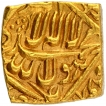This Lot is closed.
- P-Auction # 33
- Bids: 1
- Views:1062
| Start Price 500000 | Estimated Price 500000-700000 |
| login, to view Hammer value | |
| Quick Description | ||||
|---|---|---|---|---|
| Denomination | Gold Mohur (Square) | Mint | Banga | |
| Metal | Gold | |||
| Full Description: Akbar, Bang Mint, Gold Square Mohur, Obv: Arabic legend The Kalima Shahada and dotted mint mark within a diamond square, the four Caliphs’ names in the four cornors, Rev: Persian legend “Jalal ud din Muhammad Akbar Badshah Ghazi” in the centre, “khuld allahu mulkahu ta’ala” at the top, “zarb Bang” at the bottom, 10.83g, 15.92 x 15 mm, (Unlisted in KM), sharp strikes, almost uncirculated, Exceedingly Rare. Note: Bang mint gold coins usually have the Jhar (Leaf) mint mark, this specimen has the dotted floral motif alongside The Kalima Shahada. The province of Bengal was ruled successively by the Suris, Muhammad Shahis, and the Karranis as tributaries to the Mughal emperor but this was an uneasy relationship. The Bengal sultans constantly raised disputes with their overlord Akbar leading to the annexation of the province in 1577 after the deposition and execution of Daud Khan Karrani following the battle of Rajmahal. These rare first Mughal mohurs of Bang (Bangala) marked the occupation of a land that was never accepting of the Mughal rule. The new province would prove to be the wealthiest and most fertile of the empire, and the expansion of revenue brought about by the acquisition of Bengal necessitated the creation of a new imperial position in 1579, that of Diwan or minister of finance for the provinces. The Diwan served as a sort of Governor-General, responsible for the collection and distribution of funds, reporting directly to the emperor, and would have been in charge of the administration of the increasing number of provincial mints. The Diwan thus controlled the levers of power in the provinces and became the most influential figure in the imperial court.
| ||||






